Women's
monthly magazines:
Prima to Riva
This page links to profiles of women's monthly magazines, many of which are known as glossies or slicks because of their high production values and upmarket editorial. Some weeklies – such as Grazia and Riva - are included because of their attempts to establish themselves as weekly glossies. The main index page is here. The titles – past and present – are arranged alphabetically on the following pages:
- 19 to Cosmopolitan
- Easy Living to Grazia
- Harper's Bazaar to More!
- New Woman to Over 21
- Prima to Queen, Red and Riva [this page]
- Scene to Zest
- Table of top 5 sellers
- Key facts on women's monthlies
Main women's monthly magazines index page.
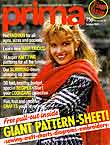 Gruner & Jahr's first issue of Prima in October 1986. The German publisher was unable to capitalise on its success and pulled out of the UK in 2000 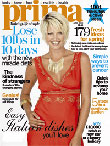 Prima in 2006: the best-selling domestic women's monthly in the UK |
PrimaGruner & Jahr (Bertelsmann) / National Magazine Company, monthly, October 1986 - Iris Burton was editor and Anthony Essam art director. Prima was typeset by Solecast in London and printed by Gruner Druck, Itzehoe, Germany. The contents of the first issue were:
Advertisers (13 pages) were:
G&J was a Bertelsmann subsidiary and had first launched Prima in 1982 in France, where it had become the top women's monthly, selling 1.4m copies an issue. Then it had gone to Germany where it was a similar success. The magazine focuses on advice on how to look and feel your best, time- and money-saving solutions, quick and easy food, beautiful homes and gardens. Prima Baby was launched as a one-off in 1997, and became a bi-monthly in 1999. G&J took its French weekly Femme Actuelle and launched it as Best in the UK in 1987. It was edited by Prima editor Iris Burton. In 2000, NatMags surprised the industry by beating IPC to buying G&J's titles when the German group withdrew from the UK. It was felt that the titles took the Cosmo publisher more downmarket.National Magazines profile Gruner & Jahr profile |
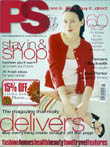 PS: a short-lived home-shopping magazine |
PS [closed]Dennis Publishing, six a year, March/April 2000 – 2001Editor Rachel Shattock brought us what was claimed to be 'The world's first home shopping magazine'. Everything featured in articles in PS could be bought by phone or over the web. It closed partly as a result of the end of the dotcom boom. Dennis profile |
 Psychologies: for 'third wave' women |
PsychologiesHachette Filipacchi UK, monthly, October 2005First launch by HFUK since Hachette Filipacchi split off from a joint partnership with Emap and took over Attic Futura to form the company in 2002. Psychologies claims to have identified a new market of 'third wave' women – 4.7m 30- to 55-year-olds who do not read a women's monthly. Psychologies is a top 3 women's magazine in France (launched 1970, sells 350,000 copies a month) and there are editions in Italy, Spain, China, Russia and the US. Editor Maureen Rice is a former editor of Options and 19. Psychologies looks for 'third wave' women HFUK profile |
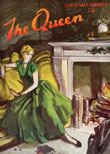 The Queen's Christmas issue in 1948 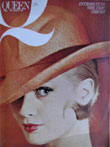 Queen from 1962 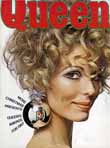 Queen, 13 December 1967 (vol 429, issue 5635). Cover shows Lady Sarah Crichton-Stuart photographed by John Vaughan 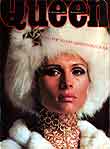 Queen in November 1968 |
(The) Queen [closed]Stevens Press Limited, monthly, 1861-1970The Queen was first published on 7 September 1861 from offices at 248 Strand, London and cost 6d. It was described as 'An Illustrated Journal and Review' and a 'Ladies Newspaper and Court Chronicle'. Jocelyn Stevens* wrote that permission was given by Queen Victoria to use the title and that the magazine was 'aimed at those people who naturally attended Court functions, and those who would love to have been invited'. It competed with Tatler. The first proprietor was Samuel Beeton (husband of cookery's Mrs). By 1955, it was published on alternate Wednesdays by the Cromwell Publishing Co. Ltd, Burleigh St, WC2 as 'The ladies' newspaper and court chronicle and dress.' Jocelyn Stevens bought The Queen in 1957 at the age of 25 as a birthday present to himself. He had inherited £750,000 and was related to the Hulton press barons: grandfather Sir Edward owned several national papers and uncle Edward launched Picture Post. Jocelyn Stevens dropped the The and turned what was a diary of the debutante world into a glossy magazine that was to ride the wave of London's Swinging Sixties. In a profile of Stevens, US news weekly Time ('Brash Young Giant', 23 Feb 1962) described 'Caroline', an imaginary young woman who personified the magazine's target audience: 'An ambitious, intelligent bachelor girl – or the same girl married to a young executive on the way up – who wants all the material things in life.' Sales rose from 45,000 in 1957 to 60,200 in 1962. Asa Briggs in his History of Broadcasting in the United Kingdom identifies two key personnel as layout editor Mark Boxer (later editor of the ground-breaking Sunday Times Magazine and Tatler) and photographer Antony Armstrong-Jones (later Lord Snowden). Stevens, Boxer and Armstrong-Jones had all been to Cambridge University and had also worked on Lilliput. Beatrix Miller was editor from 1958. Later, Dennis Hackett made his name as editor with the title until taking over as Nova editor in 1965. Jocelyn Stevens was a founder investor in pirate broadcaster Radio Caroline, which shared the magazine's Fetter Lane offices when it was launched in 1964. Queen featured 'Jennifer's Diary' by Betty Kenward, which chronicled the social activities of the upper classes for almost half a century, first in Tatler, then Queen and Harpers & Queen. Private Eye (4 Dec 1981, 521) made reference to Stevens trying to sell Queen to Lord Beaverbrook’s Express group in 1967. The Financial Times (21 November 1992) quoted Stevens as saying: 'I got bored with my readers and sold it [in 1968] for £500,000 to the man sitting at the next table at [London hotel] Claridges.' Stevens went on to become managing director of Express Newspapers and then was a founder of trade publisher Centaur. The man who bought Queen was a printer, Michael Lewis. He approached National Magazines with a view to buying Harper's Bazaar, but instead, in 1970 NatMags took over Queen to form Harper's & Queen. Legend has it that Lewis gave NatMags the title in exchange for printing contracts. H&Q dropped the Queen and reverted to the name Harper's Bazaar in 2006. *The Frontiers of Privilege: A century of social conflict as reflected in The Queen, by Quentin Crewe. Stevens Press, 1961 (foreword by Jocelyn Stevens, editor-in-chief, The Queen) |
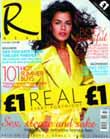 Bauer marketed its fortnightly title Real using price but eventualy sold the title 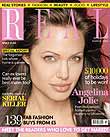 Angeline Jolie on the last issue of Essential's Real, just after it went monthly |
Real [closed]Bauer / Essential / Burda, monthly, 3-16 April 2001-March 2007Launched as a fortnightly by H. Bauer with Janice Turner as editor (Janice Turner is now a Times columnist and used to have a column about magazines in Press Gazette). Printed gravure in Germany with a laminated cover and near-monthly production values. Sold to Essential Publishing in 2004. German publisher Burda took
over Essential in April 2006. Real's fortnightly frequency
changed to monthly for the February 2007 issue. However,
just weeks after, the company suspended publication (the March
2007 issue was the last). |
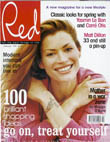 Emap used cover mounts to help increase Red's sales |
RedHachette Filipacchi UK, monthly, February 1998-Launched by Emap / Hachette Filipacchi joint venture in 1989 under editor Kathryn Brown. Coined term 'middle youth' for its target market – women who had grown out of Elle and Marie Claire but were not ready for 'middle-aged' Good Housekeeping. Red aimed for women aged 28 to 44, with a core audience of 30 to 39-year-olds. Criticised for extensive use of cover mounts to 'buy' readership. When the two companies parted in 2002, Hachette paid Emap £17m for its half stake in the magazine. HFUK profile |
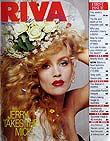 Riva – a 1988 attempt at a weekly glossy with Jerry Hall on the cover. Note the contents strip on page 3 visible because the cover was trimmed to a narrow width 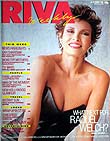 By the seventh and final issue, Riva had dropped the narrow cover. Raquel Welsh was the cover star |
Riva [closedCarlton / IPC, monthly, 13 September-25 October 1988Carlton's Riva aimed to have ‘the pace of a weekly with the gloss of a monthly’. The strategy bears comparison with later attempt to launch 'glossy weeklies' by Bauer with Real (2001, failed), Emap with Grazia (2005) and IPC Media with Look (2007). Cost 50p and first issue had model Jerry Hall (Mick Jagger's girlfriend) on cover. At £7.5 million, the launch budget was then the largest in Britain. (Bauer's weekly Bella had cost £5m the previous year.) Riva was part of a response by Carlton and IPC owner Reed to incursions in the previous year – Marie Claire to compete with Elle and Vogue at the top end of the fashion market; Essentials, a practical monthly up against Prima; and Riva facing Best and Hello!. In her first editorial, Sally O'Sullivan (who had made her name with the launch of Options) wrote: 'Riva is a weekly unlike other weeklies. It's glossy and stylish, just like the expensive monthly magazines, yet it's pacey, instant and newsy.' Coverage in the first issue included a news round-up (News Faces and This Week; pp 5-16; 24 hours with... interview p21; Shopping, p22-25; Spotlight 9Death of the shoulder pad), ppp28-30; Perfect Partnership (Bob Geldorf with Fifi Trixibelle), 31; Looks, pp32-35; Competition with Next, pp38-39; Interview (Patrick Swayze), pp40-43; You, pp46-47; Fashion, pp48-53; Working, pp 56-58; Living, 60-63; Collecting (costume jewellery), p66-68; Inside Eye, p69; Private Lives, p73; Fashion, pp74-79; Food, 82-84; Rich Talk, 86-87; Fashion, 88-91; News Report (sewage on Britain's beaches), 92-93; Who wore what, 94-96; Diary of an Affair, p98; Next week promotion, 99; Horoscope, p100; Essentials, 102. There were 30 pages of advertising. The final issue ran to 74 pages; 19 were ads. An interesting innovation by Sally O'Sullivan was a vertical contents
panel on page 3 being visible because the right of the main cover
was trimmed back. However, this entailed twice as much of the more
expensive cover stock paper being used, so would have been expensive
and was discontinued by the October 18 issue. The cover feature
continued on to pages 2 and 3, so a prime advertising slot was
also lost. The magazine
had a circulation target of 350,000, but closed after
only seven issues with sales of about 160,000. Critics said it
lacked a news edge. The Sunday Times quoted a media buyer
who was disappointed that Riva did not have the promised
upmarket feel: ‘We were expecting something like a weekly Cosmopolitan.
Instead, we got a magazine that was as up-market as a pina colada
in a Benidorm bar.' However, the short time the magazine was given
suggests it might have been a victim of politics or financial strain
at IPC (which had also recently launched Marie Claire and Essentials). Riva's
future had been put in doubt just a couple of weeks after the launch
when Carlton Magazines, a Reed subsidiary that enjoyed a semi-autonomous
existence, was placed under the direct control of IPC. Carlton's
managing director, Martin Matthews, was replaced by Colin Reeves-Smith.
Sally O'Sullivan left the company in December to become editor
of She at National Magazines (taking over from Joyce Hopkirk, who became
editor-in-chief), and then Harpers and Queen. O'Sullivan
founded her own company, Cabal,
in 1998. |


